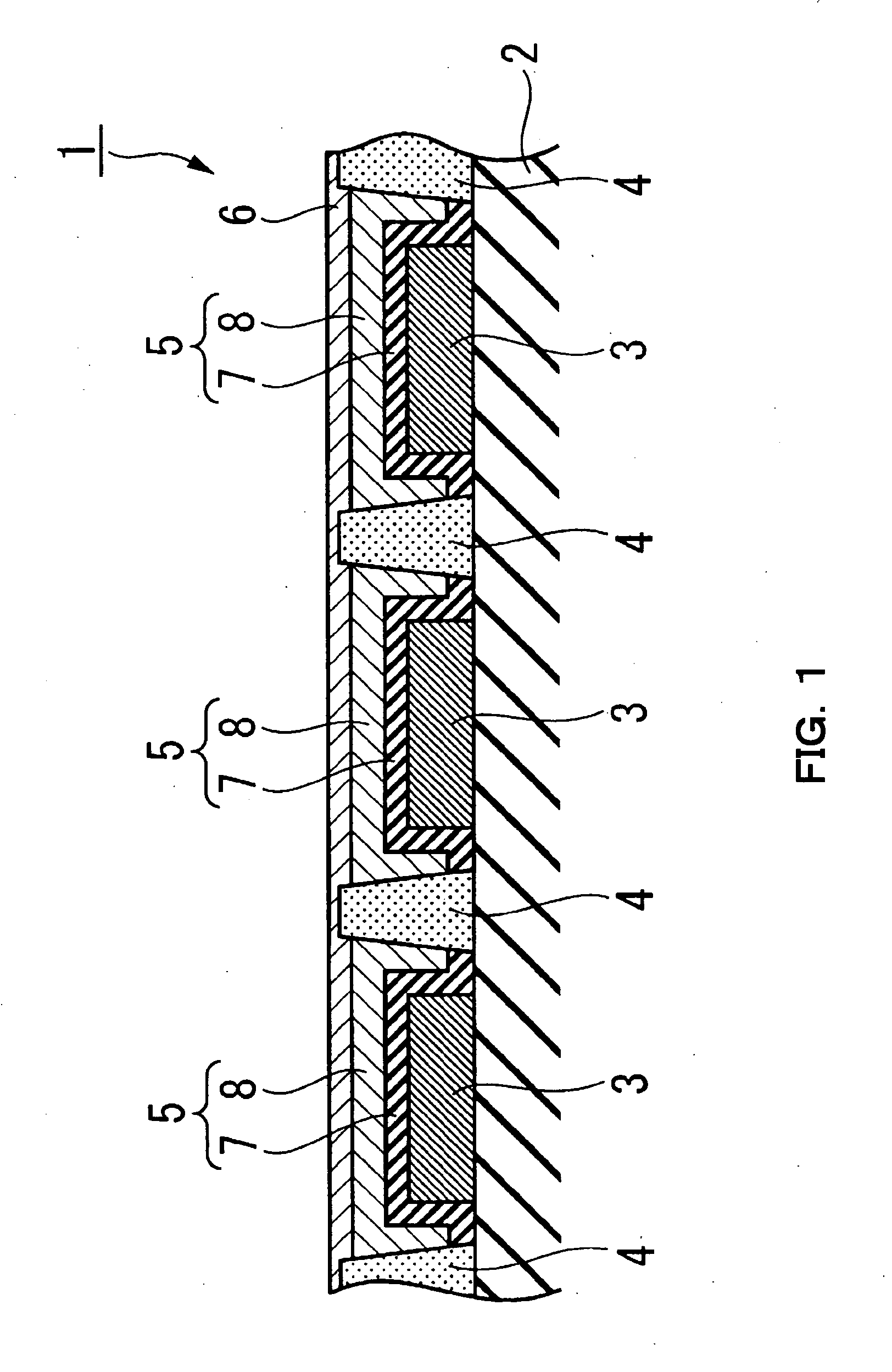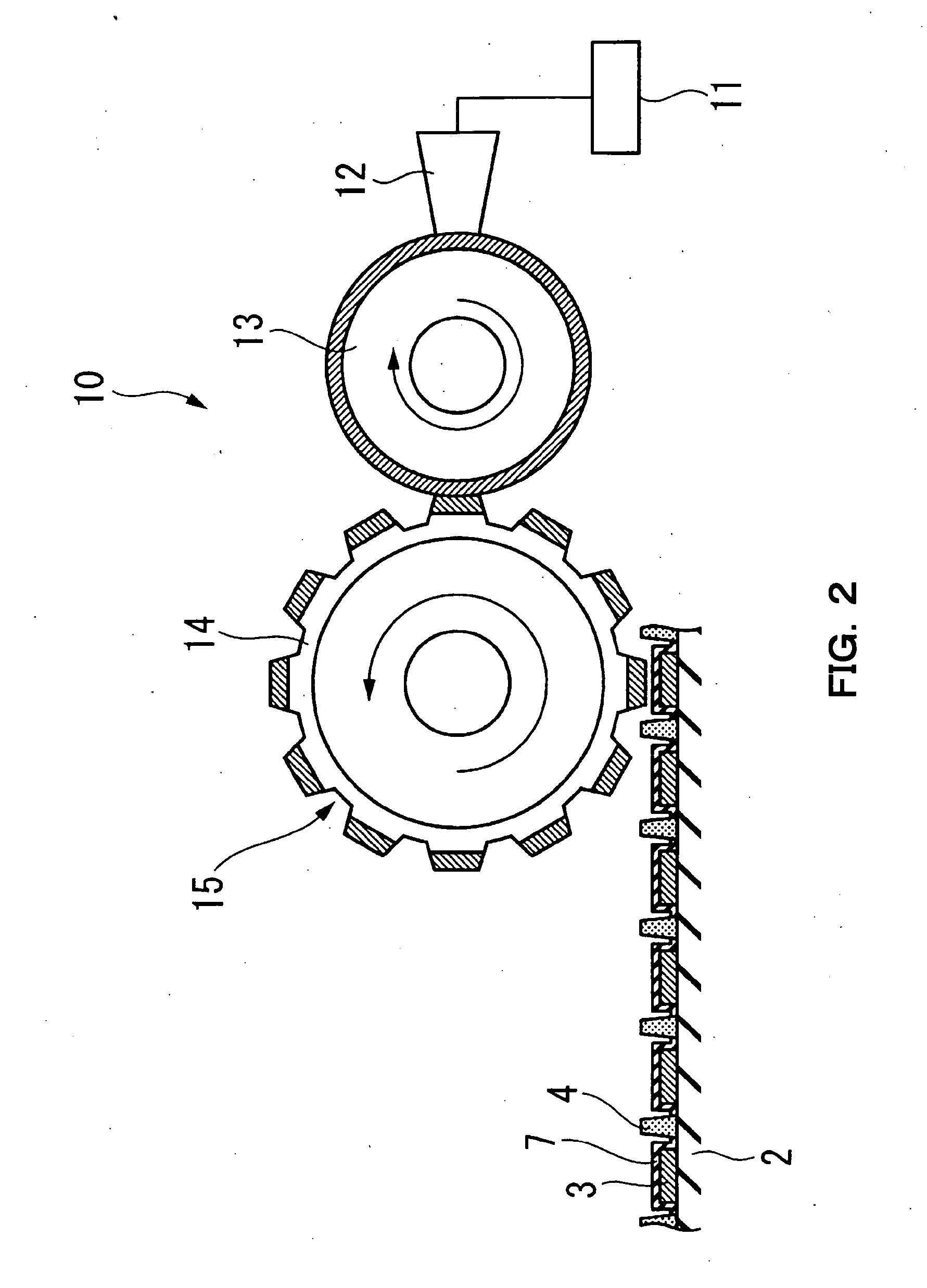Manufacturing method of organic electroluminescent device and an organic electroluminescent device
- Summary
- Abstract
- Description
- Claims
- Application Information
AI Technical Summary
Benefits of technology
Problems solved by technology
Method used
Image
Examples
example 1
[0084] Organic electroluminescent device 1 of the present invention is explained by an example next.
[0085] At first, as example 1, organic luminous layer 8 was formed by relief printing. Organic electroluminescent device was produced.
[0086] Translucency substrate 2 is explained below. It was glass of 100 mm square, and its thickness was 0.7 mm.
[0087] Transparent electrode layer 3 of configuration of a long strip of paper was formed. Width of transparent electrode layer 3 was 80 μm, and the thickness was 0.15 μm. Pitch of transparent electrode layer 3 was 120 μm.
[0088] The surface roughness Ra of transparent electrode layer 3 was 20 nm in every domain of 200 μm2.
[0089] In addition, the profile of partition wall 4 was trapezoid. The length of a side of a bottom part of trapezoid was 30 μm. The length of a side of the top of trapezoid was 15 μm. The height of trapezoid was 1 μm.
[0090] A formation method of partition wall 4 is described below. By using a photosensitive resin, deve...
example 2
[0101] Organic electroluminescent device was produced by means of forming organic luminous layer 8 by inversion offset printing next. About organic luminous layers 8, every printing of each color, they were dried under inert atmosphere at 160 degrees Celsius for 30 minutes. The thickness was 70 nm.
[0102] Voltage was applied to transparent electrode layer 3 and counter electrode layer 6 of organic electroluminescent device 1 produced in this way. The display test result that luminance was 8500 cd / cm2 in 10V applied voltage was provided. The luminescence failure pixel was not recognized.
example 3
[0103] Organic electroluminescent device was produced by means of forming organic luminous layer 8 by ink jet process next. In addition, illustration of a point same as example 1 is omitted in the embodiment.
[0104] About organic luminous layers 8, every printing of each color, they were dried under inert atmosphere at 150 degrees Celsius for 30 minutes. The thickness was 70 nm.
[0105] Voltage was applied to transparent electrode layer 3 and counter electrode layer 6 of organic electroluminescent device 1 produced in this way. The display test result that luminance was 8700 cd / cm2 in 10V applied voltage was provided. The luminescence failure pixel was not recognized.
[0106] In addition, the present invention is not limited by the above described embodiment. As for the present invention, various kinds of modification is possible in the range which does not deviate from general meaning of the present invention. By way of example only, in the above described embodiment, even active mat...
PUM
| Property | Measurement | Unit |
|---|---|---|
| Mass | aaaaa | aaaaa |
| Molecular weight | aaaaa | aaaaa |
| Area | aaaaa | aaaaa |
Abstract
Description
Claims
Application Information
 Login to View More
Login to View More - R&D
- Intellectual Property
- Life Sciences
- Materials
- Tech Scout
- Unparalleled Data Quality
- Higher Quality Content
- 60% Fewer Hallucinations
Browse by: Latest US Patents, China's latest patents, Technical Efficacy Thesaurus, Application Domain, Technology Topic, Popular Technical Reports.
© 2025 PatSnap. All rights reserved.Legal|Privacy policy|Modern Slavery Act Transparency Statement|Sitemap|About US| Contact US: help@patsnap.com



